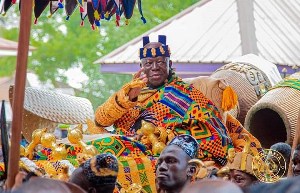Opinions of Monday, 14 November 2011
Columnist: The East African
Elmina castle, a living testimony to slavery
The Elmina Castle, Edina, Anomana or Amankwaa Kurom — it has been called many names, but one thing will never change — the malevolent history of this relic of the trans-Atlantic slave trade.
The Portuguese, the first Europeans to visit the west coast of Africa, built the castle 522 years old ago in Cape Coast town in the then Gold Coast (modern day Ghana) in 1482. The gigantic castle built on sedimentary rocks occupies 2.32 acres of land.
The site is said to have been sacred to the local population who revered it as lace of the gods. They did not therefore take it kindly when the chief gave it away to the Portuguese. A war ensued.
Upon completion, the Portuguese named it after their patron Sao Jorge (Saint George), and annexed Elmina to Lisbon, Portugal’s capital city.
First established as a trade settlement, the castle became one of a chain of forts that served the trans-Atlantic slave trade for 475 years. The castle is separated from the rest of the settlement by moats, and connected with a suspended drawbridge to control access and exit.
Today, it is all fun around the castle with people fishing, playing or trading. The fun fades as you enter the castle and are transported back in time.
The castle is divided into three courtyards: The main, the inner and the service court yards. In the main yard are dungeons which were used for holding female captives. Our guide Ato Ashun, narrates the slavery story with a solemnity that evokes empathy, sympathy, antipathy and anxiety.
Share This Story Share
The Portuguese and the Britons used the dungeons to have their way with the women slaves held ther. In cases when the governor travelled without his wife, he would order the women paraded in the court yard and chose one. The selected woman would be cleaned and dressed in the open by the soldiers for she would have gone for days without bathing.
“After this humiliation, she would be fed and taken up a flight of stairs and through a trap door off the inner courtyard called the private access to the governor’s bedroom. The woman would be returned to the dungeon and those who became pregnant were freed,” said Ato as he led us up the stairs.
The mixed race children born of such unions were given European names and educated and became middlemen between the Africans and European merchants. Today, names like Dacosta, Dasila, Vanderpuye, Viala, Laast, De Heer, Vrooms, Hutchison, and Pieterson are evidence of what happened.
Below the governor’s chamber is the female dungeon, which is dark and has a musty smell. The female slaves slept on the bare rock. I was caught between the discomfort and empathy for the slaves who lived through this.
At the beginning, the Portuguese seemingly built good relations with the African community and engaged in barter trade in items like guns, gunpowder, liquor, enamel, bowls, tobacco, and iron bars in exchange for gold, ivory, spices and African artifacts. Amazed by the volumes of gold traded, the Portuguese believed that the area was endowed with gold and thus named the place Elmina (the mine).
Unknown to the Africans, the Portuguese had an ulterior motive — to spread Christianity and counteract Islam, to access and control the gold producing lands, find new routes to the sea to India and the Far East that supplied Europe with spices.
All was going according to plan until the emergence of the trans-Atlantic slave trade. When the Portuguese monopoly over the gold trade came under threat from other Europeans, they became greedy and included human as part of the commodities traded out of Africa. They duped local chiefs to sign agreements that prohibited trading with other Europeans. Penalties were severe. A first offender would be whipped and have their ears chopped off and subsequent offences would attract detention, torture and even being exiled across the Atlantic Ocean into slavery.












